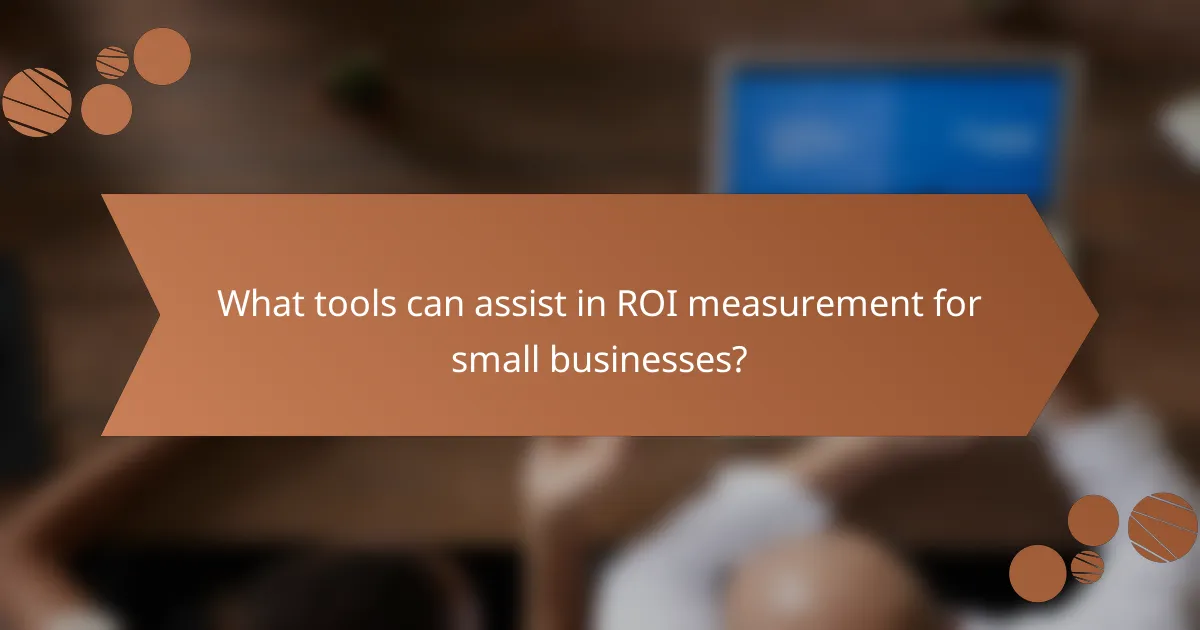Measuring return on investment (ROI) is crucial for small enterprises engaged in cross-border partnerships, as it allows them to evaluate the financial returns against their investments. By analyzing key metrics such as profit margins and cash flow, businesses can gain insights into the effectiveness of these international collaborations. Implementing best practices like setting clear objectives and utilizing data analytics tools further enhances their ability to assess financial outcomes and make informed decisions.

How can small enterprises measure ROI in cross-border partnerships?
Small enterprises can measure ROI in cross-border partnerships by evaluating the financial returns relative to the investments made. This involves analyzing various metrics and indicators that reflect the effectiveness and profitability of these international collaborations.
Utilizing financial metrics
Financial metrics are essential for assessing ROI in cross-border partnerships. Key metrics include net profit margin, return on investment (ROI), and cost-to-revenue ratios. Small enterprises should focus on calculating these metrics to understand the financial impact of their partnerships.
For instance, if a partnership leads to an increase in revenue of €50,000 with an investment of €10,000, the ROI would be 400%. This clear calculation helps in making informed decisions about future collaborations.
Implementing performance indicators
Performance indicators provide insights into the effectiveness of cross-border partnerships. Small enterprises should establish key performance indicators (KPIs) that align with their strategic goals, such as customer retention rates and sales growth. These KPIs help track progress and identify areas for improvement.
Regularly reviewing these indicators allows businesses to adjust their strategies and optimize their partnerships for better outcomes. For example, if customer retention is low, it may indicate a need for enhanced support or engagement strategies.
Leveraging customer acquisition costs
Customer acquisition costs (CAC) are crucial for understanding the efficiency of cross-border partnerships. By calculating the total cost of acquiring a new customer, including marketing and sales expenses, small enterprises can assess whether their investments are yielding profitable returns.
For example, if a partnership reduces CAC from €200 to €150, this improvement can significantly enhance overall profitability. Monitoring CAC helps businesses make data-driven decisions about resource allocation in their partnerships.
Analyzing revenue growth
Revenue growth is a direct indicator of the success of cross-border partnerships. Small enterprises should track revenue changes over time to evaluate the impact of these collaborations. A consistent upward trend in revenue can signal a successful partnership.
To effectively analyze revenue growth, businesses can compare revenue before and after forming a partnership. For instance, if a partnership results in a 20% increase in sales within the first year, it demonstrates a positive return on investment.
Evaluating partnership effectiveness
Evaluating the effectiveness of partnerships is essential for long-term success. Small enterprises should conduct regular assessments to determine whether their partnerships are meeting predefined objectives. This evaluation can include feedback from stakeholders and analysis of market trends.
Consider using a structured approach, such as a SWOT analysis (Strengths, Weaknesses, Opportunities, Threats), to gain a comprehensive view of the partnership’s performance. This method helps identify strengths to leverage and weaknesses to address for future growth.

What are the best practices for ROI measurement?
Best practices for ROI measurement involve setting clear objectives, utilizing data analytics tools, and regularly reviewing financial outcomes. These practices help small enterprises effectively assess the financial impact of their investments and partnerships.
Establishing clear objectives
Clear objectives are essential for effective ROI measurement. Small enterprises should define specific, measurable goals that align with their overall business strategy. For example, a company may aim to increase sales by a certain percentage or reduce costs within a specific timeframe.
When setting objectives, consider both short-term and long-term outcomes. This dual focus allows businesses to track immediate results while also planning for sustainable growth. Ensure that objectives are realistic and achievable to maintain motivation and focus.
Using data analytics tools
Data analytics tools are crucial for accurately measuring ROI. These tools can help small enterprises gather, analyze, and interpret data related to financial performance. Popular options include Google Analytics for web traffic analysis and various CRM systems for tracking customer interactions.
Investing in the right analytics tools can provide insights into customer behavior, sales trends, and operational efficiency. Small businesses should choose tools that fit their budget and scale, ensuring they can effectively track and measure the outcomes of their investments.
Regularly reviewing financial outcomes
Regular reviews of financial outcomes are vital for understanding ROI. Small enterprises should establish a routine for analyzing financial data, such as monthly or quarterly reviews, to assess progress against their objectives. This practice helps identify trends and areas needing improvement.
During these reviews, compare actual outcomes against projected goals. If results fall short, investigate potential causes and adjust strategies accordingly. Consistent evaluation allows businesses to remain agile and responsive to changing market conditions, ensuring better financial performance over time.

Which financial outcomes are most significant for small enterprises?
For small enterprises, the most significant financial outcomes include profit margins, return on investment, and cash flow analysis. Understanding these metrics helps businesses gauge their financial health and make informed decisions.
Profit margins
Profit margins indicate how much of a company’s revenue is retained as profit after expenses are deducted. For small enterprises, maintaining healthy profit margins is crucial for sustainability and growth. A typical profit margin for small businesses often ranges from 5% to 20%, depending on the industry.
To improve profit margins, small enterprises should focus on cost control, pricing strategies, and operational efficiency. Regularly reviewing expenses and adjusting pricing based on market conditions can also enhance profitability.
Return on investment
Return on investment (ROI) measures the profitability of an investment relative to its cost. For small enterprises, calculating ROI helps assess the effectiveness of various initiatives, such as marketing campaigns or equipment purchases. A positive ROI indicates that the investment generates more returns than its cost.
To calculate ROI, use the formula: (Net Profit / Cost of Investment) x 100. Small businesses should aim for an ROI of at least 15% to ensure that their investments are worthwhile. Regularly evaluating ROI can guide future investment decisions.
Cash flow analysis
Cash flow analysis tracks the inflow and outflow of cash within a business, ensuring that it can meet its obligations. For small enterprises, maintaining positive cash flow is vital for day-to-day operations and long-term viability. A common practice is to maintain a cash reserve that covers three to six months of operating expenses.
To conduct a cash flow analysis, small businesses should create a cash flow statement that includes all sources of cash (like sales and loans) and all uses of cash (like expenses and investments). Monitoring cash flow regularly helps identify potential shortfalls and allows for proactive financial planning.

What tools can assist in ROI measurement for small businesses?
Small businesses can leverage various tools to effectively measure ROI, enabling them to assess the profitability of their investments. Key tools include analytics platforms, accounting software, and customer relationship management systems, each offering unique insights into financial performance.
Google Analytics
Google Analytics is a powerful tool that helps small businesses track website performance and user behavior. By analyzing traffic sources, conversion rates, and user engagement, businesses can determine the effectiveness of their online marketing efforts and calculate ROI based on revenue generated from digital channels.
To maximize its benefits, set up goals and e-commerce tracking within Google Analytics. This allows you to measure specific actions, such as purchases or sign-ups, providing a clearer picture of how marketing investments translate into financial returns.
QuickBooks
QuickBooks is an accounting software that simplifies financial management for small businesses. It enables users to track income, expenses, and profits, making it easier to calculate ROI on various business activities. By generating financial reports, QuickBooks helps identify which investments yield the best returns.
Utilize features like expense tracking and profit margin analysis to gain insights into your spending and revenue generation. Regularly reviewing these reports can help you make informed decisions about future investments and operational adjustments.
HubSpot
HubSpot is a comprehensive customer relationship management (CRM) platform that assists small businesses in tracking marketing campaigns, sales performance, and customer interactions. By analyzing data from various touchpoints, businesses can assess the ROI of their marketing strategies and customer acquisition efforts.
To effectively use HubSpot for ROI measurement, focus on its reporting tools to evaluate campaign performance and lead conversion rates. This data can guide your marketing budget allocation, ensuring funds are directed toward the most effective channels.

How do cultural differences impact ROI in cross-border partnerships?
Cultural differences significantly impact ROI in cross-border partnerships by influencing communication, expectations, and business practices. Understanding these differences can lead to more effective collaboration and improved financial outcomes.
Influencing negotiation strategies
Cultural nuances shape negotiation styles, which can affect the success of cross-border partnerships. For instance, some cultures may prioritize relationship-building before discussing terms, while others may focus on direct and efficient negotiations. Recognizing these preferences can help businesses tailor their strategies accordingly.
To navigate these differences, enterprises should research the cultural backgrounds of their partners and adjust their negotiation tactics. This may involve adopting a more formal approach in certain cultures or being prepared for prolonged discussions in others. Effective negotiation can lead to better contract terms and ultimately enhance ROI.
Affecting customer preferences
Cultural differences also play a crucial role in shaping customer preferences, which can impact the success of products and services in foreign markets. Understanding local tastes, values, and buying behaviors is essential for businesses aiming to optimize their offerings and maximize ROI.
For example, a product that is popular in one country may not resonate in another due to differing cultural values. Conducting market research to identify these preferences can guide product development and marketing strategies. Businesses should consider localizing their messaging and adapting their products to meet the unique needs of each market, which can lead to increased customer satisfaction and higher returns.



